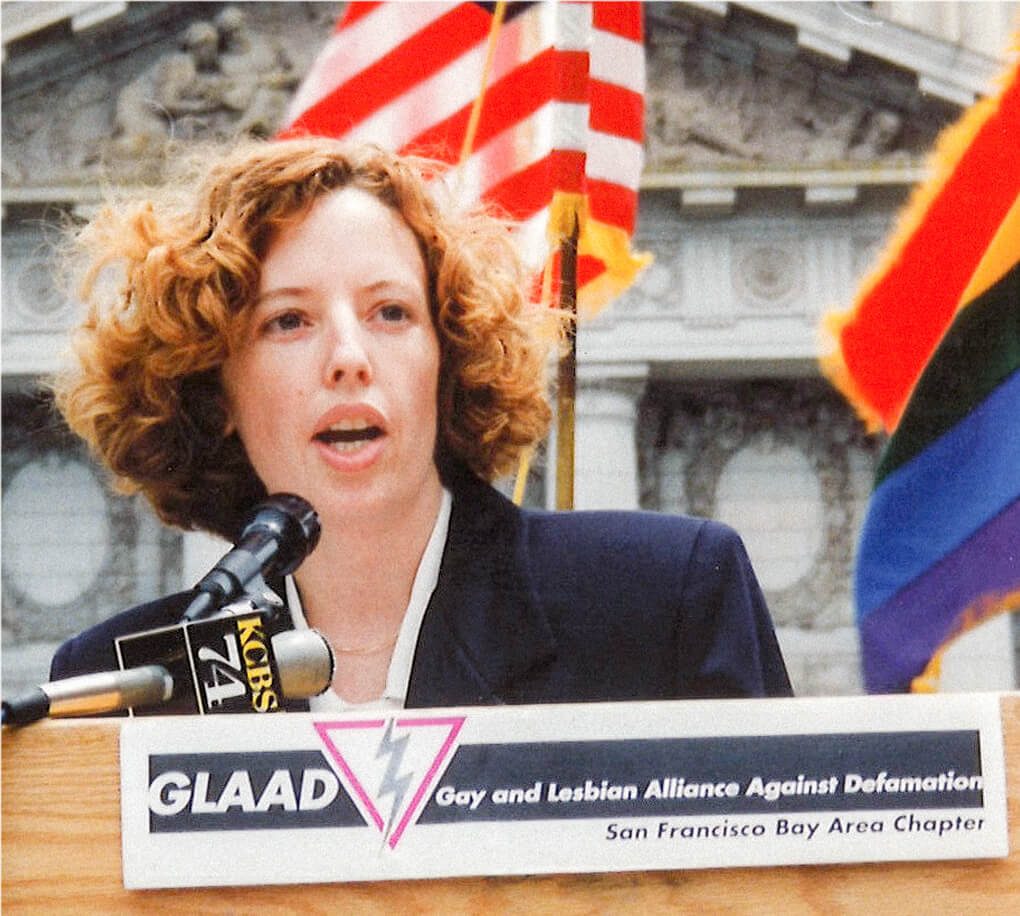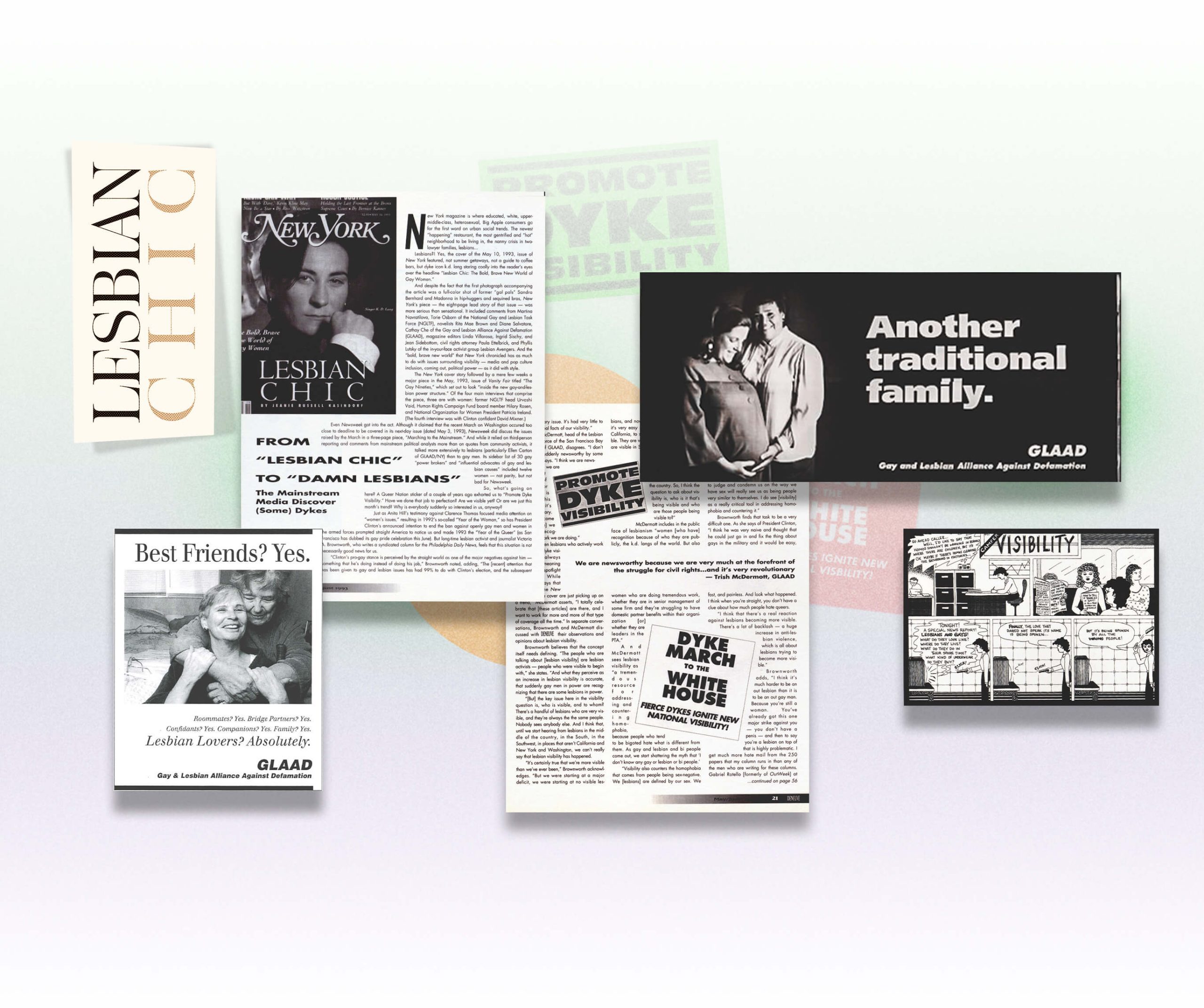Curve Archive and Outreach Manager Julia Rosenzweig looks back at the year lesbians made mainstream news. But was it a victory for visibility?
“The key issue here in the visibility question is, who is visible, and to whom?”
Victoria Brownworth, Deneuve magazine August 1993
In August 1993 Deneuve magazine—Curve magazine’s initial name—published the article “From ‘Lesbian Chic’ to ‘Damn Lesbians’: The Mainstream Discover (some) Dykes” by Kate Brandt. It was a year with unprecedented coverage of lesbians: k.d. lang graced the cover of New York magazine, GLAAD produced a billboard campaign showing a pregnant lesbian couple, and the sitting president was openly pro-gay.
Brandt’s article highlights two differing opinions on the impact of lesbian mainstream visibility on our community. Trish McDermott, then the head of the Lesbian Visibility Task Force of the San Francisco Bay Area chapter of GLAAD (Gay and Lesbian Alliance Against Defamation), insisted that lesbian visibility was “a tremendous resource for addressing and countering homophobia, because people who tend to be bigoted hate what is different from them… They need to view us as the clerk at the store, and the grandmother taking care of her granddaughter, and the homeless child on the streets.”
Alternately, Victoria Brownworth, Lambda and NLJGA award-winning journalist, purported that “the key issue here in the visibility question is, who is visible, and to whom? There’s a handful of lesbians who are very visible, and they’re always the same people…until we start hearing from lesbians in the middle of the country, in the South, in the Southwest…we can’t really say the lesbian visibility has happened.”

I was lucky enough to sit down with Trish McDermott 30 years after she had her opinions on lesbian visibility documented in Deneuve magazine. Below are excerpts (edited for clarity) from our discussion about her work in 1993 with GLAAD, how the landscape of LGBTQ+ visibility has changed, and reflections on who is doing the work to advance our visibility today.
JULIA: Could tell me about your tenure as the head of the Lesbian Visibility Task Force and what you were doing in 1993?
TRISH: In that period the work I was doing relative to lesbian visibility…of course, there’s the billboard project, and a much less public but critical project we did about senior lesbian visibility at that time that I’m just so proud of.
At the time, GLAAD had a board in San Francisco. The GLAAD team in San Francisco was a little bit more “on the ground activists raising hell” kind of a team, while it was my understanding that the GLAAD board and team in LA was doing more organizing around the entertainment industry, doing a lot of fundraising. So we function very differently.
The real purpose of the Lesbian Visibility Taskforce, part of GLAADs mission, was to address defamation in our community. And there’s a kind of defamation by omission, which is basically just “we don’t tell your story.” We control the airways, we control the books, we control the conversation, and we’re going to leave your story out of it. And so even when you were hearing in the early 1990s about the gay community, you were largely hearing about gay men. And then, on top of that, within the community, LGBTQ people of color, older lesbians… there were groups that were just not part of the conversation. This was really part of GLAADs mission.
At the same time, when there was reporting about the gay community there was terminology used in the press that was disruptive to our community. You might see a newspaper article about something random—a bank robbery or a Good Samaritan—and it might call the person an alleged homosexual, almost like you might say an alleged bank robber. There was a criminality just in the language. In those early days GLAAD did some critical work addressing how our stories were told and who was left out of those stories. That was the job of the Lesbian Visibility Task Force, to raise and uplift the stories of lesbians around the country.
We know that if young people cannot see people like them in the media that they consume, cannot hear conversations about people like them in their day to day lives, it’s very hard for them to envision a pathway from youth to adulthood. These stories really matter. The genesis of the billboard campaign was exactly that. Like, what if we could put up a billboard that showed not only a lesbian couple, and not only a mixed-race lesbian couple, but a pregnant lesbian couple? That seemed radical. It seemed like our truth also.
So I wrote a proposal and went to a billboard company called Patrick Media asking them to donate a billboard and they came back and said they in fact would be donating multiple billboards for the campaign. I think they as an organization heard and understood the need of visibility for the lesbian community. And then the project took on a life of its own. We had the Vice President of the United States making remarks about the billboard. I had death threats. We had bomb threats. Wow. We used all of that to continue to tell the story and ask questions about why these images are so threatening?” Why is the go-to response anger and violence and threats when you see a happy lesbian couple about to have a baby? So the visibility itself sparked these really important conversations about where the threat was.
The other thing that was really cool about that campaign is the phone calls from young LGBT people around the country, sometimes in tears, explaining that it had never crossed their mind that they could one day fall in love and have a baby. And so there was some controversy… the billboard was called another traditional family and there was some controversy even within GLAAD about that headline. But I really dug in on the headline because Pat and Karen, the couple on the Billboard, they as a pregnant couple were dealing with all of the traditional questions and concerns and joys that any pregnant couple goes through: Nursing or bottle feeding? When do I start saving for a college education? Where will I have the baby? Who’s hosting the baby shower? These are the beautiful traditions of becoming a parent.
So while certainly the billboards could have been more inclusive and there’s still a lot of good work regarding visibility ahead of us, I’m really proud of the campaign. I’m proud of how the community came together, of how we dealt with the threats and the anger because that’s all part of our history as activists of visibility.
JULIA: In the article you say that “lesbian visibility is a tremendous resource for addressing and countering homophobia because people who tend to be bigoted hate what is different from them. As gay and lesbian and bi people come out, we start shattering the myth that I don’t know any gay people. They need to view us as the clerk at the store, and the grandmother taking care of her granddaughter and the homeless child on the streets. And the fact that we have sex with other women is great, and we should never deny it or apologize for it. But we have a responsibility to create a full picture of our lives so that these people who are so quick to judge and condemn us on the way we have sex will really see us as being people very similar to themselves.” This is such a powerful statement and I just wonder how it resonated with you today, especially considering the rise in homophobic legislation, as well as just outright hate, honestly, towards the queer community in this current landscape?
TRISH: In all progressive movements for change, regardless of how much work we have behind us, there is still a great mountain to climb ahead of us. I am both sad to say that’s true for the LGBTQ community but also energized by it because we know how to climb. We know how to organize and we know how to affect change.
I have a lot of concern about the attack on our trans community right now because I think it is a concerted effort to make this community invisible. This is true for Don’t Say Gay in Florida schools. We have made ourselves visible as a community and the powers that be who are threatened by who we are at our very core are working very hard to disappear us. This is why we have to be more out, we have to be stronger. But also there is a responsibility of our media, of our community of our friends and family. We should be telling each other stories, highlighting and uplifting those stories.
One thing that’s been heartwarming to see, although on a small scale, is how the advertising industry has opened up to routinely make visible members of the LGBT community as they market and sell their products. You can have all kinds of conversations of if capitalism is good or bad, etc. But routine visibility of our community is helpful.
JULIA: Are there any LGBTQ rights activists that you think are recognized or should be recognized today?
TRISH: I don’t necessarily want to name names, but here’s what I see going on in the world. I see in public education they are not only out, not only visible, not only raising the profile of their LGBTQ peers, but also organized and focused and unafraid. I see students doing this work… We couldn’t have imagined 20, 30 years ago that 12 year olds and 14 year olds and 16 year olds would be as courageous and brave as they are, to stand up and be counted and support their LGBTQ community. Also straight allies who are out there doing the work side by side with them. They are certainly my heroes. Everyone benefits from this work. I can’t really name some individual or even an organization. I think it’s really a collective.
JULIA: What is your favorite incidence of lesbian or queer visibility in media today?
TRISH: One of the things I love today is the openness to explore sexual and gender orientation among our youth. To think about it, to have conversations about, to disclose it. I hear young children identifying as bisexual or queer or lesbian and feeling empowered by that identification. The progressiveness and acceptance and affirmation I see happening in our LGBTQ youth, to me, marks a moment. No matter who says “we can’t say gay” our youth are affirming each other in a truly loving and progressive and life altering way, and that’s just big, good, happy news.
Billboard photo by Chloe Atkins, courtesy of the San Francisco Public Library. Comic by Jennifer Camper from Deneuve, August 1993. Other photos courtesy Trish McDermott.
